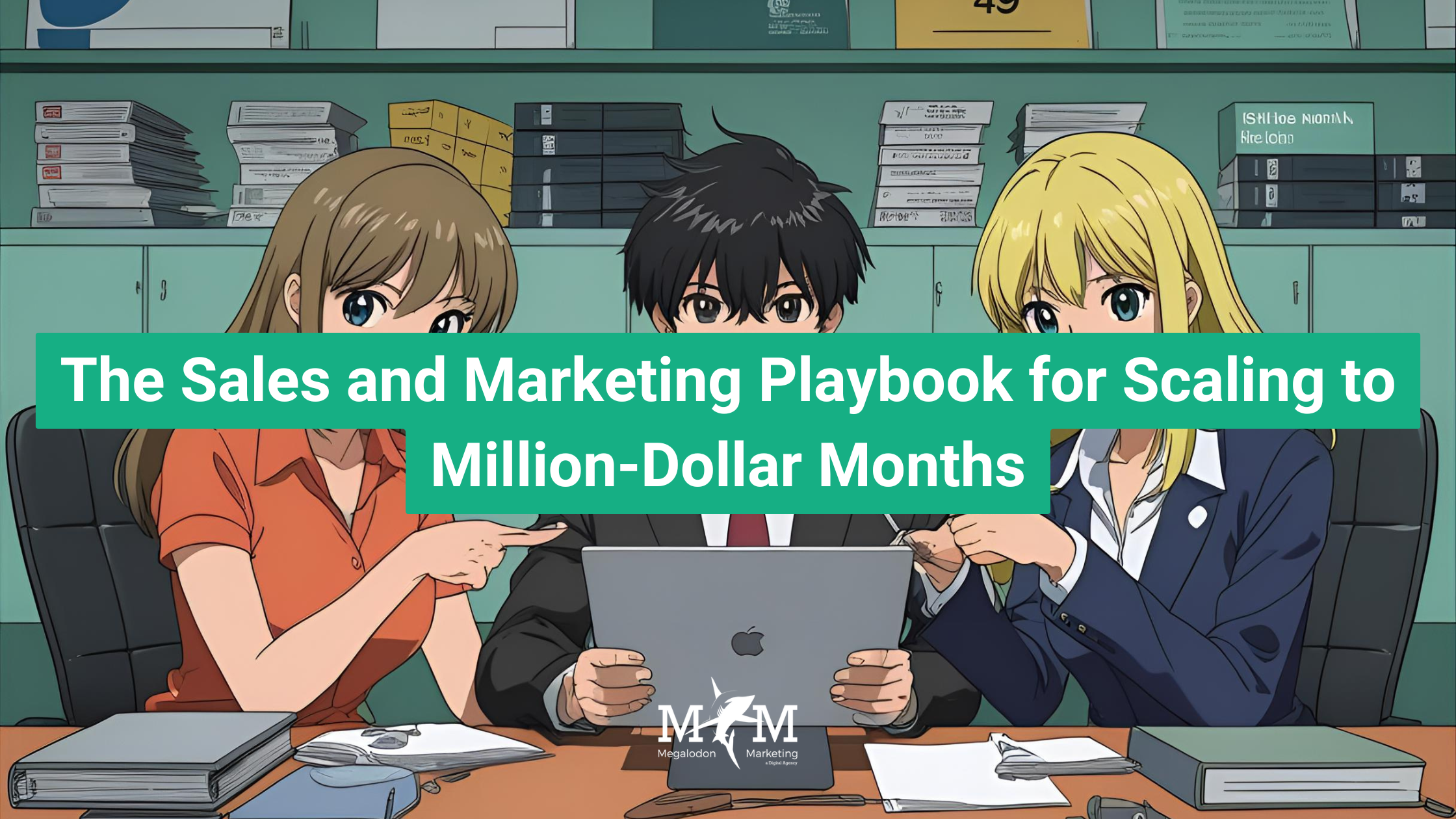I hope you enjoy reading this blog post. If you want my team to just do your marketing for you, click here.

I hope you enjoy reading this blog post. If you want my team to just do your marketing for you, click here.
Author: Jeremy Haynes | founder of Megalodon Marketing.

Earnings Disclaimer: You have a .1% probability of hitting million dollar months according to the US Bureau of Labor Statistics. As stated by law, we can not and do not make any guarantees about your own ability to get results or earn any money with our ideas, information, programs or strategies. We don’t know you and, besides, your results in life are up to you. We’re here to help by giving you our greatest strategies to move you forward, faster. However, nothing on this page or any of our websites or emails is a promise or guarantee of future earnings. Any financial numbers referenced here, or on any of our sites or emails, are simply estimates or projections or past results, and should not be considered exact, actual or as a promise of potential earnings – all numbers are illustrative only.
Watch the full video breakdown on this topic here.
If you’ve been in the high-ticket space for any amount of time, you’ve seen it:
A business grinds up to $250K–$300K/month… and then just sits there.
It’s not that hard to hit that range. You don’t have to be the best at what you do. With a $10K offer and decent sales reps, two closers can put you in that range. It’s 20–30 sales a month—hard work, yes, but not rocket science.
The issue? Staying there.
Example: A client doing ~$300K/month for a full year without growth. When we stepped in, their metrics were solid—4x ROAS, healthy profits—but no CRM. They were literally running off a spreadsheet. Hiring was another mess: four reps, one “half-setter,” and constant trouble finding talent.
We didn’t overhaul the entire system. We:
Four months later: $1.77M cash collected in a single month.
Lesson: The leap from hundreds of thousands to seven figures monthly often comes down to simple, obvious fixes applied fast.
Most sales leaders obsess over the wrong numbers. Show rate, close rate, average order value—they matter, but they’re not the number.
The KPI that tells you almost everything in one glance is Collected Dollar per Booked Call.
Formula:
Example:
It’s a keystone metric because it wraps every sales performance variable into a single number. Once you know it, you can instantly measure ROAS, track rep efficiency, and make call allocation decisions.
Close rate alone is dangerously misleading. A rep could inflate it by:
Sure, their percentage looks amazing… but your revenue suffers.
Your culture should reward efficiency with the company’s resources—not vanity stats. For every $200 you spend to put a call on the calendar, how much does that rep return? That’s the question.
There are two schools of thought:
We bias toward #2. Why? Because the performance delta—the gap between your best and worst reps—is the single most expensive factor in a sales org.
Example: A few points difference in close rate plus a few thousand in ASP can equal a $100K/month swing per rep.
Scaling isn’t just about “more calls.” It’s about profitable calls. That’s where call economics come in.
Rule of thumb: Collected $ per Booked Call should be 4–5x your Cost per Booked Call.
Example:
If your funnel’s economics don’t support this, you have to change:
We reject deals where the numbers don’t work. Example: $400 CPC, $6K offer—margins too thin unless you crush industry benchmarks.
Our favorite right now? Cold traffic webinar funnel.
Why:
Frequency matters.
Live > automated. If you can stomach ~5% less performance, automation can work, but it will almost never beat live numbers.
We’ve taken two near-identical deals—same niche, similar offers—and seen one rocket to $2M/month while the other flatlined. The difference?
Trust.
Founders who trust the people they’ve brought in—whether sales leadership, marketing partners, or both—implement faster and scale faster. Those who let ego override expertise burn months arguing instead of executing.
If you’re not the most qualified person in the room on a given subject, hire someone who is and listen to them.
We hire based on:
The cost of ignoring these? A rep with massive potential burns out, coasts, or turns into a liability—dragging ROI, morale, and opportunity cost down with them.
Here’s where most sales managers blow it.
New rep joins. Week 1: 30 calls, no deals. Panic sets in. But…
What to do instead:
Premature pressure + overcorrection is how you take a good hire and tank them in their first month.
Even with the right KPIs and patience during ramping, some reps never stabilize.
The tell: KPI “yo-yo” behavior. They’re up one week, down the next, back up again… and over a quarter, the downs cancel the ups.
Rule: If they miss KPI three times in a quarter, they’re done—regardless of recent “good weeks.” The inconsistency kills predictability, which kills scaling.
When you combine speed, data discipline, and the right people in the right seats, million-dollar months stop being a dream and start being a process.

Jeremy Haynes is the founder of Megalodon Marketing. He is considered one of the top digital marketers and has the results to back it up. Jeremy has consistently demonstrated his expertise whether it be through his content advertising “propaganda” strategies that are originated by him, as well as his funnel and direct response marketing strategies. He’s trusted by the biggest names in the industries his agency works in and by over 4,000+ paid students that learn how to become better digital marketers and agency owners through his education products.

Jeremy Haynes is the founder of Megalodon Marketing. He is considered one of the top digital marketers and has the results to back it up. Jeremy has consistently demonstrated his expertise whether it be through his content advertising “propaganda” strategies that are originated by him, as well as his funnel and direct response marketing strategies. He’s trusted by the biggest names in the industries his agency works in and by over 4,000+ paid students that learn how to become better digital marketers and agency owners through his education products.
This site is not a part of the Facebook website or Facebook Inc.
This site is NOT /endorsed by Facebook in any way. FACEBOOK is a trademark of FACEBOOK, Inc.
We don’t believe in get-rich-quick programs or short cuts. We believe in hard work, adding value and serving others. And that’s what our programs and information we share are designed to help you do. As stated by law, we can not and do not make any guarantees about your own ability to get results or earn any money with our ideas, information, programs or strategies. We don’t know you and, besides, your results in life are up to you. Agreed? We’re here to help by giving you our greatest strategies to move you forward, faster. However, nothing on this page or any of our websites or emails is a promise or guarantee of future earnings. Any financial numbers referenced here, or on any of our sites or emails, are simply estimates or projections or past results, and should not be considered exact, actual or as a promise of potential earnings – all numbers are illustrative only.
Results may vary and testimonials are not claimed to represent typical results. All testimonials are real. These results are meant as a showcase of what the best, most motivated and driven clients have done and should not be taken as average or typical results.
You should perform your own due diligence and use your own best judgment prior to making any investment decision pertaining to your business. By virtue of visiting this site or interacting with any portion of this site, you agree that you’re fully responsible for the investments you make and any outcomes that may result.
Do you have questions? Please email [email protected]
Call or Text (305) 704-0094